#Arecibo Telescope
Note
Fun Fact Fridaaaaay!
Today You Learned about the Arecibo Telescope and Observatory:

Until the completion of FAST in China in 2016, the Arecibo Telescope in Puerto Rico was the world’s largest radio telescope, and it was completed back in 1963. Aside from looking like the awesomest place to skateboard ever of all time, the telescope used radar to observe objects in space. And it made several discoveries, including the true length of Mercury’s rotation period, the detection of Comet Encke, and the first direct image of an asteroid. It was also a major part of the Search for Extraterrestrial Intelligence (SETI) Project, with it beaming a pixelated message into space to see if anyone would pick up and answer back. Probably unsurprisingly, there are tons of stories about UFOs above Puerto Rico.

The University of Utah tells me the original message was in black and white though.
Also! There was an attached museum with tons of cool science exhibits about astronomy.
Sadly, in the early 2000’s, NASA decided to cut funding to the telescope. There were plenty of advocates, and it continued to operate for over a decade…until it was heavily damaged in 2017 during Hurricane Maria, and in 2020, before much could be done to save it, the entire thing collapsed. There are efforts to replace it and preserve parts of the old telescope, but I don’t know how that’s going.
Also, it appeared in a James Bond movie.
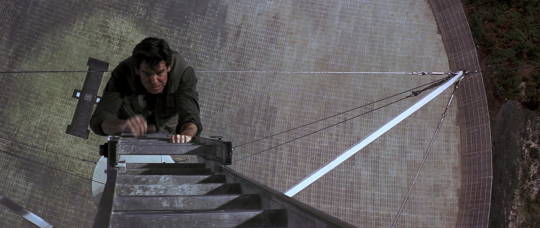
Pierce Brosnan didn’t actually climb that thing though; reportedly it was a stunt double because in real life Brosnan is afraid of heights (something he’s a bit sensitive about, I think).
#Fun Fact Friday#Hispanic Heritage Month#Today You Learned#Puerto Rico#Arecibo Telescope#astronomy#SETI Project#NASA#Arecibo#James Bond#Pierce Brosnan
14 notes
·
View notes
Text
Aliens RESPOND to the Arecibo Message!
It may be a surprise, but I am only now reading 1st book on UFOs ( I have been mostly interested in aliens as fiction or in ttRPGs). I just learned about the Arecibo Message.
Frank Drake sent a message of 1679 bits to his fellow UFO friends and said that this was a mathematical message he wanted to send to the aliens. While not all cultures share language, we all share math.
To test if it was…

View On WordPress
#adventure#alien#aliens#Arecibo Message#cartoon#Cartooning#exploration#fiction#funny#life on other worlds#martians#math#pixel art#prime numbers#radio telescope#rpg#science fiction#search for intelligent life#semi-prime numbers#semiprime numbers#semiprimes#spaceship#Tabletop RPGs#the truth is out there#UAP#UFO#Unidentified Aerial Phenomenon#Unidentified Flying Object
2 notes
·
View notes
Link
In this episode of SpaceTime, the mystery of the famous "Wow!" signal may finally be solved, the European Space Agency's Cluster mission is set to end in a fiery re-entry over the South Pacific, and Earth gets hit by another powerful solar storm. Join us for these fascinating updates and more!
00:00:00 - This is SpaceTime series 27, episode 104, for broadcast on the 28 August 2024
00:00:45 - New study may have identified the source of the famous "Wow!" signal
00:12:30 - European Space Agency's Cluster mission to end with a controlled re-entry
00:23:45 - Earth hit by another powerful solar storm
00:32:15 - The science report: Higher levels of plant fats linked to lower risk of heart disease
00:45:00 - Neuralink's brain implant shows promising results in second trial patient
For more SpaceTime, visit our website at www.spacetimewithstuartgary.com
www.bitesz.com
Become a supporter of this podcast: https://www.spreaker.com/podcast/spacetime-with-stuart-gary--2458531/support
Sponsor Link:
NordPass
ProtonMail & Security
Malwarebytes
NordVPN
#arecibo#aurora#australis#big#borealis#cluster#ear#esa#flare#magnetar#magnetosphere#mission#observatory#radio#seti#signal#solar#storms#telescope#wow
0 notes
Text

"Human activity has brought my kind to the brink of extinction, but I don't blame them for it. They didn't do it maliciously. They just weren't paying attention."
[source] | [source]
#uploads#offscreendeathshots#ted chiang#the great silence#aliens#extraterrestrial#colonialism#interstellar#anthropocene#anthroprocentrism#extinction#arecibo#telescopes#astrophysics#dr. fatima#parrots
0 notes
Text
lil review of netflix's alien worlds:
overall it's a very pretty docuseries, but content-wise it's bit disappointing for me. not enough time was spent on each planet, and i wanted to see more of the cool critters!
it's far less focused than alien planet, but it's certainly a fun intro to the spec-bio genre
so, enjoy!
0 notes
Text

Today, the 14th of August of 2023, is the first day after the closure of the Arecibo Observatory. I have no deep words to mark this occasion. Only an endless well of grief, punctuated by one final happiness: I and my husband were married there on the 29th of July, and it was every bit as hectic and beautiful as the Observatory itself. I couldn't have hoped for a better goodbye.
Big thanks to my friend Rushaa for this picture.
1 note
·
View note
Text

Beneath Venus' Clouds - September 24th, 1996.
"If the thick clouds covering Venus were removed, how would the surface appear? Using an imaging radar technique, the Magellan spacecraft was able to lift the veil from the face of Venus and produce this spectacular high resolution image of the planet's surface. Red, in this false-colour map, represent mountains, while blue represents valleys. This 3-kilometer resolution map is a composite of Magellan images compiled between 1990 and 1994. Gaps were filled in by the Earth-based Arecibo Radio Telescope. The large yellow/red area in the north is Ishtar Terra, featuring Maxwell Montes, the largest mountain on Venus. The large highland regions are analogous to continents on Earth. Scientists were particularly interested in exploring the geology of Venus, because of its similarity to Earth."
91 notes
·
View notes
Text
A GALAXY THAT HAS NO STARS??
Blog#381
Wednesday, March 6th, 2024.
Welcome back,
There’s a galaxy out there without apparent stars but largely chock full of dark matter. What’s that you say? A galaxy without stars? Isn’t that an impossibility? Not necessarily, according to the astronomers who found it and are trying to explain why it appears starless. “What we do know is that it’s an incredibly gas-rich galaxy,” said Green Bank Observatory’s Karen O’Neil, an astronomer studying this primordial galactic object. “It’s not demonstrating star formation like we’d expect, probably because its gas is too diffuse.”
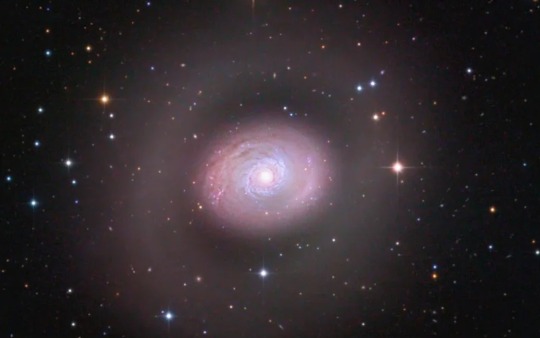
O’Neil and a team of colleagues found this odd, seemingly starless object called J0613+52, while they were doing a sky survey. Their target was a set of so-called “Low Surface Brightness” galaxies (LSBG) They used the Green Bank Telescope, the Arecibo Telescope (before its untimely end), and the Nançay Radio Telescope to look at 350 of these dim, diffuse objects. The idea was to survey them and determine their gas content and dynamic masses.
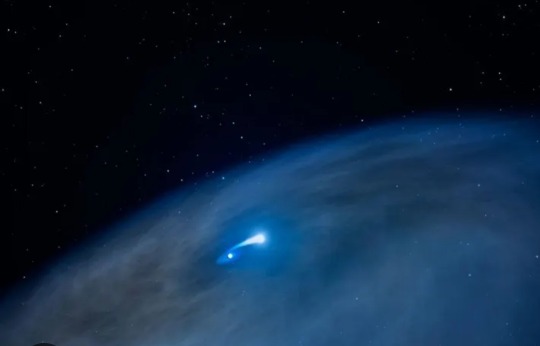
J0613+52 wasn’t one of the team’s original targets. Instead, they stumbled across it while trying to figure out why some of the data from Green Bank and Nançay didn’t match, according to O’Neil. “The GBT was accidentally pointed to the wrong coordinates and found this object,” she explained, noting that this galaxy was new and unknown. There are no galaxies within 112 parsecs, making it a pretty isolated target.

Interestingly, based on their observations, the team found that J0613+52 has about the same characteristics of mass and gas content as a normal spiral. Yet, it has no stars. That poses a mystery they’d like to solve.
The type of galaxy represented by J0613+52 is an odd one when you compare it to the more familiar types such as the star-filled spirals and ellipticals. For one thing, it’s a dwarf galaxy with an irregular shape. Without any obvious stars, it’s quite dim. The most unusual thing about objects like this one is that dark matter appears to dominate their compositions.

If J0613+52 is like others, it could have up to 95 percent dark matter constraining the neutral gaseous hydrogen that we can detect.
So, why no stars in J0613+52? O’Neil describes it as an “unevolved” dwarf. That’s because the neutral hydrogen gas component is too diffuse, and too spread out. LSBG generally have less gravity and that makes it tough to form stars on their own. So, they evolve very gradually. If they do start to convert gas to stars, it takes a long time for that to happen.
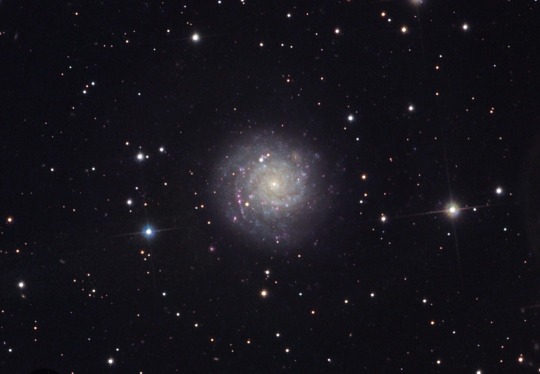
Some astronomers suggest that LSBG are late-forming objects in cosmic time. That might explain the presence of this one in relatively “modern” times.
In addition, J0613+52 lies too far from any neighboring galaxies to interact with them gravitationally. That means they can’t trigger star formation through any possible mergers or collisions. “J0613+52 appears to be both undisturbed and underdeveloped,” she said. “This could be our first discovery of a nearby galaxy made up of primordial gas.” That means its gas content is largely unchanged over time.
Originally published www.universetoday.com
COMING UP!!
(Saturday, March 9th, 2024)
"WHAT MAKES A BLACK HOLE GROW NEW STARS FROM??"
#astronomy#outer space#alternate universe#astrophysics#universe#spacecraft#white universe#space#parallel universe#astrophotography
109 notes
·
View notes
Note

The Arecibo Radio Telescope, near Arecibo, Puerto Rico (but only from 1963-2020, after which it collapsed)
41 notes
·
View notes
Text
Quirks and features of the James Webb Space Telescope

The James Webb Space Telescope (JWST) is a ten billion dollar space telescope that weighs 14,000 pounds, is the size of a bus, and took decades to construct. It's been in the news recently, you might have heard about it.
The development, launch and deployment of the JWST were fraught with unexpected setbacks, terror and frights, 344 "single-point failures", any one of which that, if they failed during deployment, could doom the entire spacecraft to uselessness, since it orbits far out beyond where any current manned spacecraft could even attempt a repair job.
The fact that it came online as smoothly as it did was something of a surprise to the people in charge. Given the miracle of it making it to space at all, the press coverage of JWST has focused on the positives. But a stroll through the JWST user documentation by a curious reader reveals much that is interesting, or interestingly broken. Such as..
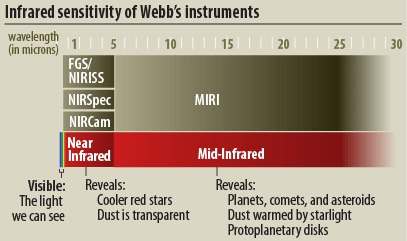
Fun and games with infrared
Specifically, the JWST is an infrared telescope, designed to collect light that's redder than red. The two dedicated imaging instruments are the Near Infrared Camera (NIRCam) collecting light from 0.6 micrometers to 5.0 micrometers and the Mid-Infrared Instrument (MIRI) collecting light from 5.6 micrometers to 25.5 micrometers. (Though with significant light collected past 25.5 um by filter F2550W)
The wonderful thing about infrared astronomy is that everything emits blackbody radiation, and the hotter it is the more infrared it emits. The unfortunate thing about infrared astronomy is that everything emits blackbody radiation, including your telescope, and self-emission from your telescope can swamp the faint signal from astronomical sources. (Like building a camera out of glowsticks.)
The equilibrium temperature for an object in Earth orbit is about 300 Kelvin. (26C) Everything on the other side of the sunshield passively cools down to 40K, and MIRI is actively cooled by the cryocooler down to a chilly 6K (-267C, -449F) This extends MIRI's seeing range deeper into infrared.
But the mirror is still warm! At the far end, MIRI is significantly compromised by thermal self-emission: (Note log scale!)
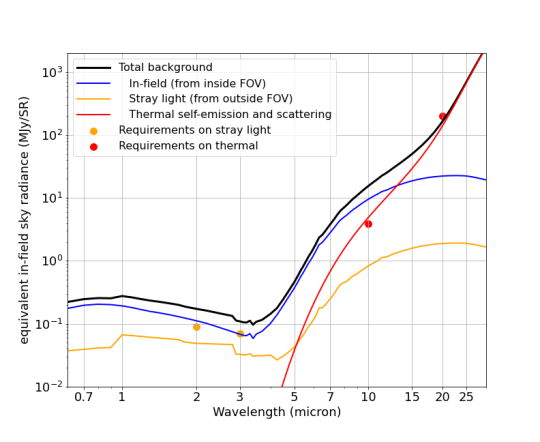
This is more graphically illustrated by one of the MIRI commissioning images:

Check out that background glare!
(This is somewhat unfair: the calibration target here is a star, which emits comparatively little light in far-infrared. MIRI is really meant for nebulae and extra-galactic high-redshift objects)
("Why not actively cool the mirror?" Mechanical cryocoolers operate on the very limit of what heat engines are capable of. The MIRI cryocooler draws a fat 180 watts to move 78 milliwatts of heat. Previous infrared telescopes used a fixed amount of expendable coolant (liquid helium or solid hydrogen) to cool the entire instrument package... at the cost of a much smaller primary mirror and a telescope that flat out just stopped working when it ran out of coolant.)
There's something else you might notice about the above series of photographs...
Thanks a lot, Lord Rayleigh
John William Strutt, 3rd Baron Rayleigh was a typical early physicist in that he has a great big pile of "discoveries" by virtue of being the first person to 1) notice something and 2) actually write it down. One of them is the fundamental theorem for the angular resolution of an optical system, the Rayleigh criterion. It is dead simple:

Resolution is roughly equal to 1.22 times the wavelength of the light you're looking at, divided by the diameter of the aperture. Bigger the opening at the front of light bucket, the higher the resolution. Smaller the wavelength of light, the higher the resolution.
(Fun fact: the former Arecibo radio observatory, once the largest single telescope in the world with a 305 meter wide dish, had about the same angular resolution in radio waves as the human eye does in visible light.)
You can imagine the effect this has on an infrared telescope. And sure enough, in the user documentation for the two imaging sensors, it states a pixel scale of 0.031 arcseconds for 0.6 to 2.3 micrometers light wavelength, 0.063 arcsec/px for 2.4-5.0 µm, and a squishy 0.11 arcsec/px for 5.6-25.5 µm.
But this is just how many pixels are on the detector. The resolution gets much worse at long wavelengths, as you can see in the commissioning image, where the extra pixels oversample a progressively vaguer blob. The Rayleigh criterion holds that the 6.5 meter wide JWST primary mirror should manage 0.206 arcsec at 5.32 µm, falling to 0.42 arcsec at 10.85 µm, 0.747 arcsec at 19.29 µm, and an unfortunate 1.014 arcsec at 26.2 µm. One wonders why the designers went to heroic lengths to cool MIRI down to 7 kelvin, instead of using that cryocooler mass and power budget for more detector surface area.
Knowing this, you can spot how the JWST's press team works around the limitations of the telescope. Like how a "look at how good our infrared telescope" commissioning photo happens to use the 7.7 µm mode:

Or how if you browse the photos on the webbtelescope.org site, you will see lots of NIRcam output in the "oooh, ah, new desktop background" category, but not so much MIRI.
(Another amusing detail of MIRI is that bright objects leave afterimages ("latents") on the sensor, so once a week they warm the sensor up to a tropical 20 kelvin before cooling it down again, a "MIRI anneal". You can see when anneals are performed, as well as what the telescope is looking at right now, by viewing the public schedule.)
But this is Webb operating right up to its full specifications. How about something that's actually broken?

NIRSpec my beloved
The Near-Infrared Spectrograph (NIRSpec) instrument takes incoming light and runs it through a diffraction grating to produce a spectrum. When scientists say that the Sun is 0.77% oxygen, 0.29% carbon, etc, it's not because someone flew a spacecraft over to it and collected a bucket of solar plasma, it's because you can look at the absorption lines in the spectra to figure out its composition.
Spectrometry is also used to measure redshift, a close proxy to distance. When a press release says that a galaxy is "ten million lightyears away", it's not because NASA has a really long tape measure they haven't told anyone about, it's because a spectrometer measured how much cosmological redshift has moved a spectrum line. Naturally, it's not quite as easy as pointing a sensor at a object and getting back a single, unambiguous result. Distant objects are also dim objects, so the spectra will be noisy and chewed up by dust and other contamination its endured in the millions of years its traveled to arrive at our telescopes. Bleeding edge astronomy is thus the practice of designing statistical models to fit to noisy, fragmented data, and then arguing with other astronomers about r^2.
In any event, it's a handy thing to have on a telescope. Naturally, JWST has more than one. In fact every instrument has a spectroscopy mode. Besides the dedicated NIRISS and NIRSpec instruments, both NIRcam and MIRI include diffraction gratings in their filter wheels that smear out incoming light, like looking through a prism:
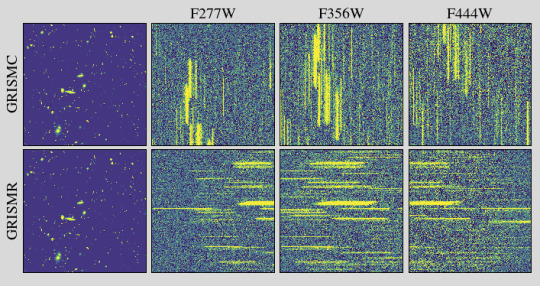
Pointing the JWST at an object is relatively expensive, since it requires rotating ("slewing") the entire darn spacecraft, and an amusingly complex alignment procedure with the fine guidance sensor and fine steering mirror. Considering how long it would take to shoot a hundred spectra with a conventional fixed slit rigidly mounted to the telescope frame, you can see the appeal of gathering a hundred spectra in a single exposure with "slitless" spectroscopy.
(Longtime space telescope nerds might hear the word "slewing" and involuntarily twitch, recalling that the reaction wheels and gyroscopes were a problem point on the Hubble, requiring several servicing missions, and also significantly affecting operations on the Kepler space telescope. Fortunately, JWST switched to a gyroscope type that has no moving parts, and used some mass budget to install six reaction wheels, up from Hubble's four, giving it three spares.)
You can also see the big downside in the image above, which is there's a hard tradeoff between how long a spectrum can be (and thus its resolution!) before it'll overlap its neighbors and be useless. Most of the slitless modes therefore have two gratings at two different angles, (GRISMR and GRISMC above) but wouldn't it great if you could just block out all that other light?

Thus, the Micro Shutter Array, as seen above. The best of both worlds! Capture many spectra at the same time, while blocking off light you don't want from contaminating the field, using a configurable array of nearly a quarter million microscopic, individually actuated moving shutters.
Lots and lots and lots of tiny little moving parts, installed in the guts of a spacecraft that's orbiting out past the Moon, impossible to access or replace.
Yeah, a bunch of them broke:

When it was handed over to NASA for installation into Webb in 2007, the MSA already had 150 shutters that no longer responded to opening commands in just one of the four submodules.
By the time JWST emerged from commissioning and was declared fully operational in 2022, 15,893 shutters, 7% of the total, had "failed closed." Hilariously, 904 of those failed during post-launch testing, and the authors of that paper note that, on average, if you tell 100 shutters to close, 4 of them will jam shut and no longer work.
This is unfortunate, but fairly easy to work around. What's worse are the shutters that are stuck open:


These permanently open shutters then compromise big chunks of the sensor. Commissioning testing jammed two more of them open, taking the total up to 22. You can imagine that if a few dozen more of these fail-open during routine operation then the entire microshutter array observation mode won't be much more useful than regular slitless spectrography.
And this, right here, sums up the essentially "interim" nature of JWST. After all, it was only supposed to cost $500 million and take a mere nine years from design to launch. All becomes clear in that light. Why give it a shutter array that falls apart in use? Why have the mirror exposed to space, where it gets hit with micrometeoroids? Why only design it to carry ten years worth of fuel? Because it was supposed to be half the price of Hubble!
The 90s was the era of "faster, better, cheaper". JWST was going to be an incremental improvement on a long series of previous infrared telescopes, and a stepping stone to the next one. It wasn't supposed to be an eternal monument to Science, and a financial black hole consuming NASA's entire budget.
So what went wrong?
We shouldn't have built one JWST.
Those 344 single points of failure. Any single one of them can end the mission. There's just one telescope, no backups, no trying again. Bureaucrats are harshly punished for failure, lightly rewarded for success. It's always easier to wait, do more tests, delay the schedule a bit more at a hint of trouble. Engineers can get you to 90% reliable no problem, but getting to 99% reliable takes another decade and nine billion more dollars.
Our techne is just bad at producing flawless machines first try. For the price of one reliable JWST we could have put twenty into orbit... but the first five would have been embarrassing failures. Spars sticking in place, sunshields jamming, thrusters misfiring. To save the shame of $0.5 billion wasted, NASA happily spent $9.5 billion. Why not? Because money spent is invisible, but failure is painfully apparent.
A critical third party can draw unflattering parallels. The crowning achievement of NASA, the Moon Landing... required eleven Apollo launches and twenty Surveyor launches before a single man set foot on lunar regolith! Quite a few of those spacecraft pancaked into the Moon and exploded on the launchpad before we figured out this "space" thing. Three men died! But NASA was on a hard deadline, with a fixed budget, and the only way to get a home run is to take a lot of swings at the ball.
Another comparison is the Space Launch System, NASA's attempt to make the Saturn V again. So far $27 billion has been lit on fire to put exactly one test load into orbit, with the primary contractor now desperate to get out of its contact. Slow, careful, incremental development has completely failed to produce a working launch system.
Meanwhile, SpaceX produced a series of public, embarrassing failures... resulting in the world's only reusable launch system, and as a result has put far more mass into orbit than any country in the world.
The only way to develop a flight system is flight tests.
Space telescope deploy mechanisms meant to work in zero gravity can't be tested on the ground.
They can only be tested in space.
NASA administrators who didn't work during Apollo are too stupid to understand this. Fire them all!
These geriatrics have happily sacrificed science in order to play it safe and secure their own easy retirement. Do we want 15 risky JWST telescopes by 2010, or do we want one reliable one by 2022? The answer is obvious!

For the money we wasted making Webb more reliable, we could have launched a space telescope far outside the disk of dust in the inner solar system, allowing it to see deeper into space than Webb ever could. ESA put an astrometry space telescope just outside Earth orbit, measuring angles between stellar objects, which is the only way to directly measure the distance to the stars. Great first step. The obvious next step is to send more of these telescopes out past Neptune's orbit, to capture better observations with a vastly larger baseline, something that can never be done by an Earthly observatory. Are there any plans to do this? No!
Space exploration is paralyzed by boomers, mired in the mental tarpit of the 1970s, where each gram to orbit is terribly expensive and must be counted on punched cards and summed with slide rules. Meanwhile, SpaceX Starship is on its way to orbit, and each one can carry sixteen JWSTs with room to spare!
The old paradigm is done. Telescopes don't need folding mirrors and exotic materials, they need to be mass produced. There is no excuse not to have a hundred more JWST-class telescopes lined up next to the Texas launch pad waiting for Starship to come online. But as far as I know not a single space mission even mentions it-- that's how afraid they are of risk!
The JWST, with its myriad of fragile components and its staggering price tag, stands as a monument not to our ingenuity but to our inability to let go of outdated ideals.
We must abandon the notion that space is a realm reserved for the flawless and the infallible. Instead, we should embrace the chaos, the unpredictability, the sheer messiness of exploration. Let us launch a thousand telescopes, each a patchwork of parts, each destined to fail in its own spectacular way. For it is only in this embrace of the ephemeral that we can find out what actually works!
Let the JWST be the last of its kind, a relic of a bygone era. The future is unwritten, and it is ours to fill with a symphony of failures, each note a step closer to the stars.
279 notes
·
View notes
Text
«Question: Why is Carl Sagan so lonely?
(a) Sagan is lonely because, as a true devotee of science, a noble and reliable method of attaining knowledge, he feels increasingly isolated in a world in which, as Bronowski has said, there is a failure of nerve and men seem willing to undertake anything other than the rigors of science and believe anything at all: in Velikovsky, von Daniken, even in Mr. and Mrs. Barney Hill, who reported being captured and taken aboard a spacecraft in Vermont.
(b) Sagan is lonely because, after great expectations, he has not discovered ETIs in the Cosmos, because chimpanzees don't talk, dolphins don't talk, humpback whales sing only to other humpback whales, and he has heard nothing but random noise from the Cosmos, and because Vikings 1 and 2 failed to discover evidence of even the most rudimentary organic life in the soil of Mars.
(c) Sagan is lonely because, once everything in the Cosmos, including man, is reduced to the sphere of immanence, matter in interaction, there is no one left to talk to except other transcending intelligences from other worlds.
Thought Experiment: You are Sagan and you are monitoring the Cornell University radio telescope at Arecibo, Puerto Rico, when, after years of reception of random noise, you receive a signal which can only be interpreted as representing the prime numbers, 1, 2, 3, 5, 7, 11, 13, 17, 19, 23… Communication is established! The source of the transmission must be Alpha Centauri because of the direction and the transmission time: four years. Years pass. A code is agreed upon. But time is running out. You are growing old. What with the difficulties of encoding and decoding and the period of transmission, there is only time for five simple questions. Which questions would you ask, and how would you answer these five questions from Alpha Centauri?
Are you in continuity with other organisms on P-3, S-G2V (third planet = earth, star G2V = our sun)?
If not, what is nature of discontinuity?
Are you in trouble?
If so, specify.
What information do you need? (E.g., what can we do for you?)»
— Walker Percy: Lost in the Cosmos
15 notes
·
View notes
Text

"A large Arecibo-like radio telescope on the Moon uses a crater for structural support. In the background are 2 steerable radio telescopes. Artwork done for NASA by Pat Rawlings, of SAIC."
Date: February 1995
NASA ID: S95-01561
21 notes
·
View notes
Text
currently running the NASA ttrpg campaign in cosmic patrol. i previously had a series of lukewarm ttrpg experiences because of my own brain badness and that turned me away from playing for a while. i forgot how to have fun 😭 but now we're so back baybeeeeeeee

anyway this is Dr. Arecibo F. Paradox (his real legal name.) he's like if one of them billionaires died and all their money went to an eccentric and excruciatingly lonely child. and then he pissed it all away on his childhood dream of imaging black holes.
the hubble space telescope teleported him and his """Co-P.I.s""" to fantasy cici's pizza. and he's having a GREAT time.
#he has a former labrat named cygnus x-1 who lives in his labcoat as an emotional support animal but i forgot to draw him ):#its so funny to have to design another mad scientist type right after noa.#listen. spindlewheel said 'eccentric heir cosplaying as a scientist that nobody wants around but he's funding their research' not me#i think he could hunt elon musk for sport#uncaptioned tag#sorry friends
16 notes
·
View notes
Video
undefined
tumblr
Miss Universe Puerto Rico 2022 National Costume
This national costume features 42 pieces of biodegradable plastic designed and 3D printed. The elements form and specifically represent the main reflector and Gregorian dome of the Arecibo Radio Telescope. Also, pay homage to our Miss Universe Marisol Malaret, Deborah Carthy Deu, Dayanara Torres, Denise Quiñones, Zuleyka Rivera, Roberto Clemente, Tito Trinidad, Monica Puig and our flag and the coquí.
#miss universe#miss universe puerto rico#puerto rico#miss universe 2022#national costume#national costume contest#pageant#I love the back idk how i feel about the front#but i like that they tied in space since she's an aerospace engineer
69 notes
·
View notes
Note
she delta on my rune till i under inside her tail
^ this what they sent out with the arecibo telescope back in '74
68 notes
·
View notes


